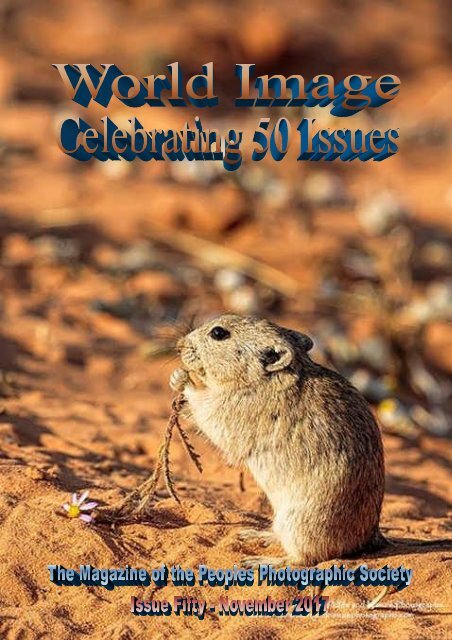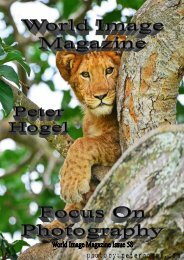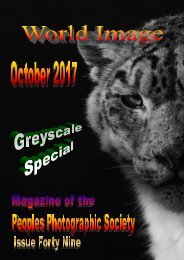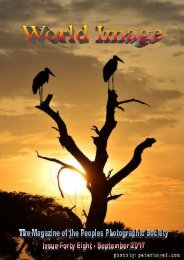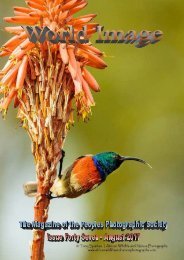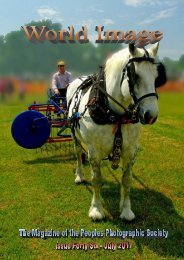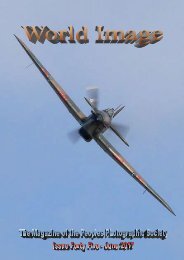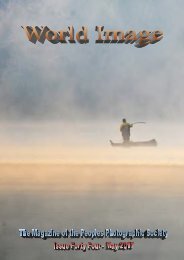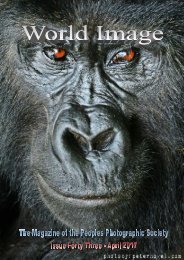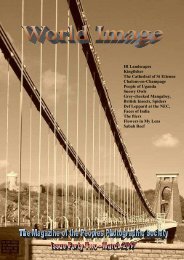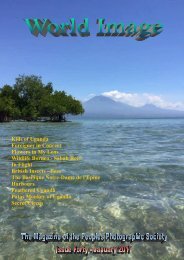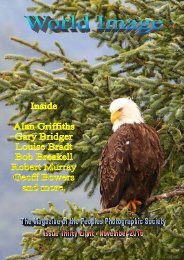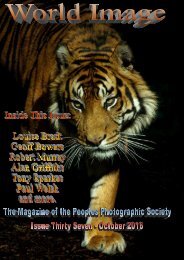Create successful ePaper yourself
Turn your PDF publications into a flip-book with our unique Google optimized e-Paper software.
Website = photosociety.net Page 1 email = magazine@photosociety.net
Gordon Longmead - England - CEO<br />
Peter Hogel - Uganda - Deputy CEO<br />
Scott Hurd - Namibia<br />
Tom Coetzee - South Africa<br />
Paul Welch—Australia<br />
National and Regional Management<br />
Steve Cook - USA<br />
Robert Murray - Scotland<br />
Tina Andreasson - Sweden and Mexico<br />
Jack Glisson - Kentucky USA<br />
Dear Readers,<br />
It is with some regret that I am replacing the index to this issue of the magazine<br />
with this announcement.<br />
It is perhaps fitting that the final issue of the <strong>World</strong> <strong>Image</strong> Magazine in its<br />
current form should also be the <strong>50</strong>th Celebration <strong>Issue</strong>.<br />
The magazine relies on distribution by word of mouth and sharing through<br />
social media, it was always going to remain a free publication and as such also<br />
relied on contributors doing so for free. During the last three years many<br />
thousands of people have shown their support in social media but most in a<br />
shallow way, very few bothered to share and promote, but we still achieved a<br />
good following.<br />
I would like to thank our readers who have made the effort worth while,<br />
although the readership varied from 700 to 10,000, the average held around<br />
6000 until recent months during which time it has dropped away.<br />
I would like to thank also those people who have joined the facebook groups<br />
and remained loyal supporters and contributors that have enabled me to<br />
maintain the magazine to this point.<br />
I would rather finish this phase on a high note than allow the magazine<br />
readership to drift away to nothing.<br />
The Magazine and Society may yet continue in a different form, that will<br />
depend entirely on others, but for now I wish you well.<br />
Gordon Longmead.<br />
© Please remember that all articles and images published in this magazine are copyright protected<br />
Cover picture - Brants's Whistling Rat (Parotomys brantsii) by Tony Sparkes<br />
Website = photosociety.net Page 2 email = magazine@photosociety.net
I shot this photograph on a recent venture in South Africa's Kruger National Park. I came across several<br />
elephants having a great time in the water and stayed photographing them for some time. There are those odd<br />
occasions when you are lucky enough to get two pictures for the price of one if you see what I mean.<br />
Over the last 20 years I have been privileged enough to travel to many of the world's great wildlife destinations<br />
with particular emphasis on Southern Africa. This in turn has allowed me to photograph many of the iconic and<br />
spectacular species found in these wonderful locations and meet some amazing people. Therefore it gives me<br />
great pleasure to announce some exciting news ..... Starting in 2018, I shall personally be leading and guiding<br />
small groups (2-4) of people, on Wildlife, Birding and or Photographic safaris in some of the world's top<br />
wildlife locations. We want to bring affordable and unforgettable wildlife experiences to people, who, like me<br />
many years ago, wish to experience, perhaps for the first time, a wildlife adventure of a lifetime.<br />
We are currently busy putting together various itineraries for three of the world's iconic wildlife destinations<br />
viz. South Africa, Sri Lanka and Malaysia. A brand new website is being worked on with a lot of hard work<br />
going into it to bring you an easy to navigate site with news about safaris, photographs, blogs, newsletters and<br />
hopefully much more.. However, in the short term and to greatly assist us in receiving some relevant<br />
information, from you our potential clients in putting together suitable tour packages for you, we have put up a<br />
small website at http://www.tonysparkes.com There you can register your interest on your preferred<br />
destination, preferred type of package; be it general wildlife, photographic or birding along with your preferred<br />
length of tour. Once registered you will be among the first to receive our tour packages for your preferred<br />
destination and possibly get some early-bird discounts. If you would like to contact us with any other questions,<br />
please use our ''contact us'' page which can also be found on the site.<br />
Thank you all in anticipation and hope to see you all real soon on an unforgettable wildlife experience.<br />
#tonysparkes #wildlifesafaris #personalsafariguide #birdsafaris<br />
www.tonysparkes.com<br />
Website = photosociety.net Page 3 email = magazine@photosociety.net
This young male lion (Panthera leo) photographed here in South Africa's Kruger National Park, certainly<br />
has an intent look on his face. The winter colours of the dead grasses that he is cowered in certainly gives<br />
him great cover and camouflage. Male lions seldom live longer than 15 years in the wild, as injuries<br />
sustained from continual fighting with rival males greatly reduce their life span.<br />
Tony Sparkes, South Africa<br />
One of the characters of South Africa's Kgalagadi<br />
Transfrontier Park a female Ground Squirrel (Xerus<br />
inauris).<br />
I managed to get up close and personal with this little<br />
squirrel while walking about our camp, A good angle<br />
to get down nice and low for the photograph, she didn't<br />
seem to mind at all. Not sure who was more inquisitive<br />
me or her.<br />
Fact: Ground squirrels are omnivorous, and will not<br />
only eat a diet rich in fungi, nuts, fruits, and seeds, but<br />
also occasionally insects, eggs, and other small<br />
animals.<br />
Tony Sparkes, South Africa<br />
Website = photosociety.net Page 4 email = magazine@photosociety.net
Returning from a late afternoon game drive while in the Kgalagadi Transfrontier Park in South Africa's<br />
Northern Cape, I spotted this pair of Bat-eared fox's (Otocyon megalotis) stood in the dry riverbed road<br />
just before camp. Unlike many species of savannah animal who use existing burrows and dens dug by<br />
other animals. Bat-eared fox's use self-dug dens for shelter from extreme temperatures and winds<br />
Tony Sparkes, South Africa<br />
Earlier in the year I visited for the first time Bontebok National Park, Nr Swelledam in South Africa's<br />
Western Cape. This antelope species (Bontebok) specific park which it is named after is a picturesque<br />
park buzzing with life. The majestic Langeberg mountains provide a picturesque backdrop for this park<br />
along with the gentle flowing Breede river running along its south western border, making it both a<br />
wildlife and landscape photographers dream location.<br />
Fact: Bontebok antelope have been brought back from the brink to roam freely in sustainable numbers with<br />
Bontebok numbers having increased from a mere 17 in the park to around 3 000 world wide.<br />
Tony Sparkes, South Africa<br />
Website = photosociety.net Page 5 email = magazine@photosociety.net
The iconic South African Springbok (Antidorcas marsupialis). Theses two antelope were captured 'Pronking' in<br />
South Africa's beautiful 'Mountain Zebra National Park' located in the Eastern Cape during a very cold mid<br />
winters morning.<br />
Fact: This is a behavior of quadrupeds, in particular gazelles, in which they spring into the air, lifting all four<br />
feet off the ground simultaneously. Scientist say some evidence exists that in some cases its a signal to<br />
predators that the 'stotting' animal would be difficult to catch. Tony Sparkes, South Africa<br />
Another one of my favorite birds (I have so many) to watch and listen to is the Crested Barbet (Trachyphonus<br />
vaillantii) With its thick bill and very colourful plumage the Crested Barbet is an unmistakable bird in Sub-<br />
Saharan Africa. Their colours blend well in the African bush but what sets them apart from many birds is their<br />
distinct trill that can continue for long periods.<br />
Fact: Crested Barbets are very territorial birds often aggressive towards other birds in their territory and they<br />
also chase off nest competitors, including other Barbets. Tony Sparkes, South Africa<br />
Website = photosociety.net Page 6 email = magazine@photosociety.net
Website = photosociety.net Page 7 email = magazine@photosociety.net
Website = photosociety.net Page 8 email = magazine@photosociety.net
Website = photosociety.net Page 9 email = magazine@photosociety.net
A Study in Nature<br />
Wildlife of America - Colourful Quakers by Larry Hitchins<br />
Mandarin Duck<br />
Mallard<br />
Red Crested Porchard<br />
Red Crested Porchard Hen<br />
Wood Duck<br />
Ferruginous Porchard<br />
Website = photosociety.net Page 10 email = magazine@photosociety.net
A Study in Nature - Sparrow Hawk<br />
Pictures by Scott Latham<br />
The Sparrow Hawk is common through out Britain<br />
except in parts of Scotland. It is a woodland hunter<br />
for which its flying skills are well suited. Although<br />
common it is not so often seen. Its speed in flight<br />
tends to make it difficult to identify to the general<br />
public.<br />
The Harris Hawk is not a native of the UK, but of the USA, it is a very popular bird of prey with the<br />
hawking community. Ot is naturally aggressive and will attack anything that enters its perceived domain,<br />
including people who get to close to its cage. Birds owned by hawkers are better behaved and are used to<br />
control rodents which, like all raptors, is a favourite pastime.<br />
Website = photosociety.net Harris Hawk - Pictures Page 11by Scott Latham email = magazine@photosociety.net
I decided to build a reflection pool for my garden as part of a long-term plan to make my garden wildlife<br />
friendly. I also wanted to get closer to the wildlife in my garden in order to photograph it. Plan hatched<br />
I began my project by researching how to do it.<br />
Having chosen the location (outside my studio) and decided that I wanted it to be mobile (in case I<br />
changed my mind) I set about designing it.<br />
I came up with an 8 foot by 2 foot design with a separate base and top. Armed with my plan and<br />
measurements I went to my local builders merchants to buy timber, plywood, wood glue, screws and<br />
some new drill bits to help with screwing it all together using my electric drill, simpler than hand<br />
screwing I thought.<br />
The first thing I did was build the base. To keep it strong enough to support the top I have 6 legs and<br />
three middle cross sections. There is also a perimeter around the top and bottom for added strength with<br />
the bottom able to be used as shelving for props.<br />
Second stage was to build the top with stronger timber for the edges and a base of plywood to support the<br />
pond liner.<br />
I discovered afterwards that<br />
plywood comes in standard sizes<br />
and lucky for me my design was<br />
that size!!!!<br />
My plywood base has no joins and<br />
is just one solid piece. I had to<br />
build this outside as it was too large<br />
to build it in the garage!<br />
Website = photosociety.net Page 12 email = magazine@photosociety.net
Next was the pond liner. This came from the local garden centre and was cut from a roll of thick liner to<br />
the size I needed. I laid it in the top and secured the sides with tacks and filled it with water.<br />
The finished reflection pool currently sits in location so that the<br />
birds get used to it. It will provide a reliable source of water for<br />
birds to drink and bathe in and with the attraction of food should<br />
provide photographic opportunities also……watch this space!!!<br />
When the berries are gone and food is scarce I hope to obtain a<br />
good selection of images to show you in future editions.<br />
Janette Hill LRPS, DPAGB, AWPF, LSINWP, LSITTP<br />
I provide photography holidays and workshops through Natural Wonders Photography and so spend<br />
much of my time overseas capturing images of wildlife, nature, travel and landscapes. See<br />
www.naturalwondersphotography.co.uk<br />
||Morning in Kolkata , India by Subhasish Bhattacharya<br />
Website = photosociety.net Page 13 email = magazine@photosociety.net
Website = photosociety.net Page 14 email = magazine@photosociety.net
Website = photosociety.net Page 15 email = magazine@photosociety.net
Website = photosociety.net Page 16 email = magazine@photosociety.net
Website = photosociety.net Page 17 email = magazine@photosociety.net
Bob Breakell - Lebanon in 1970 - 1971.<br />
Website = photosociety.net Page 18 email = magazine@photosociety.net
Lebanon Today - Hamza Ajami.<br />
Aychiyeh south Lebanon<br />
Website = photosociety.net Page 19 email = magazine@photosociety.net
The Albuquerque International Balloon Fiesta was founded in 1972,<br />
with only 13 balloons, and takes place annually in October over nine<br />
days, with fourteen sessions.<br />
The Sugar Skull is named Tru-Lee New<br />
Mexico.<br />
The <strong>2017</strong> theme was “Inflate your Imagination.” Each day starts with<br />
Dawn Patrol. Early balloons are inflated and glow in the pre-dawn as<br />
they launch.<br />
The Pink Zebra balloon is named<br />
Ca-Zoo-ee<br />
Website = photosociety.net Page 20 email = magazine@photosociety.net
The Special Shape Rodeo features some<br />
very creative and interesting balloon<br />
creatures such as animals and cartoon or<br />
movie characters.<br />
On weekends and Wednesdays,<br />
hundreds of balloons are<br />
launched in Mass Ascensions.<br />
Some of those Mass Ascensions<br />
include the “special shape”<br />
balloons, which are those<br />
balloons that have appendages or<br />
r a i s e d<br />
features.<br />
A few evenings include the<br />
Special Shape Glowdeo<br />
during which time the<br />
balloons are inflated/<br />
illuminated but stay on the<br />
ground. The evening events<br />
culminate in a spectacular<br />
A f t e r G l o w<br />
f i r e w o r k s<br />
show.<br />
Balloons are launched by race crews on the ground. The<br />
process begins by unfurling the balloon until it is flat on the<br />
ground. A large fan is used to fill the balloon envelope with<br />
cold air.<br />
Website = photosociety.net Page 21<br />
The<br />
email<br />
owl<br />
= magazine@photosociety.net<br />
is named Owlbert Eyenstein.
alloon to keep it from rising.<br />
A crown piece is fastened to<br />
the top of the balloon to<br />
hold the air inside.<br />
Gradually, warmer air is<br />
mixed with the cold air,<br />
using a propane burner, until<br />
the balloon is upright. A<br />
crew member holds a rope<br />
attached to the top of the<br />
The Rainbow Heart balloon is named<br />
Levity.<br />
The pilot and passengers<br />
climb into the basket<br />
beneath the balloon before<br />
launch.<br />
A race official, known as a<br />
“Zebra” wearing black and<br />
white referee attire, has to<br />
give the balloon pilot<br />
permission to take flight.<br />
Once the approval is given, the race crew releases any ropes and the<br />
balloon rises quickly above the ground.<br />
The balloons fly for<br />
approximately one hour,<br />
riding the gentle wind<br />
currents above the field, and<br />
most land in or near the<br />
same field.<br />
The ideal flight path follows the “Albuquerque Box” effect, a local wind<br />
pattern that pilots use to their advantage.<br />
Winds at low altitude carry the balloons south, and at higher altitudes<br />
bring them Website north, = looping photosociety.net them back toward the launchPage area. 22 email = magazine@photosociety.net
Race crews with their chase<br />
vehicles assist with the landing,<br />
and deflation of the balloons<br />
and removal from the field.<br />
Everything depends on the<br />
weather conditions which can<br />
change every day, if it is too<br />
windy the balloons are not<br />
allowed to launch.<br />
One of these balloons is the Tie Dye balloon which is named Gloria Caeli.<br />
, just for fun, I will let you decide which one it is.<br />
In <strong>2017</strong>, there were 5<strong>50</strong> regular<br />
shaped balloons and 101<br />
special shapes at the<br />
Albuquerque International<br />
Balloon Fiesta.<br />
Over a million spectators<br />
attended over the nine days,<br />
and were allowed on the field where it is possible to get very close to the<br />
balloons and pilots.<br />
Balloon Fiesta Park is a 77-acre<br />
grass field. The photography<br />
opportunities are tremendous.<br />
Fiesta organizers estimate that<br />
over 25 million photographs<br />
will be taken at this event.<br />
In <strong>2017</strong>, spectators used more than 6 terabytes of data on their mobile<br />
devices during the Fiesta, which equals 17 million selfies' worth of<br />
uploads.<br />
Mark your calendar for next<br />
y e a r ’ s A l b u q u e r q u e<br />
International Balloon Fiesta, to<br />
be held October 6-14, 2018, and<br />
“Get Carried Away.” Find more<br />
information at<br />
www.balloonfiesta.com<br />
Website = photosociety.net Page 23 email = magazine@photosociety.net
Website = photosociety.net Page 24 email = magazine@photosociety.net
Website = photosociety.net Page 25 email = magazine@photosociety.net
Website = photosociety.net Page 26 email = magazine@photosociety.net
Website = photosociety.net Page 27 email = magazine@photosociety.net
Black and white images<br />
remind me of the past. The<br />
dull days of post war 19<strong>50</strong>s<br />
when all the photos I saw<br />
were in shades of grey. I<br />
remember the first colour<br />
supplements of the Sunday<br />
papers and was blown<br />
away by the vibrant colours. I did not ‘do’ photography because with the simple<br />
cameras I could afford the colour (and the pictures) were so poor. Then came<br />
Digital. I could set my camera to Vibrant, and adjust the images in editing suites to<br />
give me the colours that I had seen.<br />
I often shoot panoramas, as above, to capture as much as possible. That one was<br />
from a ship as we sailed away from Pitcairn Island in the Pacific. Every sunset is<br />
different, some spread across the horizon, some reach up into the sky. One day the<br />
colours are subtle another vivid. I love them all and will wait and watch as the sun<br />
goes down.<br />
Sometimes it is disappointing, the colour<br />
does not a pear, the cloud comes in and<br />
kills it, but then after the sun has sunk<br />
below the horizon the colour pops up for<br />
a minute or two and CLICK – an image<br />
that others have missed. Here is one<br />
from Christmas Day in York. As we<br />
walked back to my son’s house the sky<br />
lit up and looked as if it was on fire for about three minutes. I just clicked, clicked<br />
and clicked and got this shot. It seemed like an extra Christmas present.<br />
I am sometimes up at sunrise, especially if I’m on a cruise holiday. The bottom<br />
image was taken with my first Olympus SLR E420 back in 2009 as we sailed into<br />
Palma Majorca. Again, a multi shot panorama.<br />
Website = photosociety.net Page 28 email = magazine@photosociety.net
This <strong>Image</strong> was taken from a layby on the A17<br />
near RAF Cranwell. I was driving home and<br />
watching this sunset develop and was able to<br />
pull into the layby. Traffic was whizzing past and<br />
I did not have a tripod so I leant against the car,<br />
used Aperture mode, made sure <strong>Image</strong><br />
Stabilization was on and held the camera a still<br />
as possible. The light trails and reflections in the<br />
car were a real bonus.<br />
Sometimes when I don’t seem to have much<br />
time to capture these images and can’t<br />
decide on the settings I want, I use the<br />
camera’s preset ‘Sunset’ mode. In this mode<br />
the camera software accentuates the reds<br />
oranges and yellows in an image and<br />
reduces the greens and blues. This often<br />
gives me the perfect shot with very little post<br />
production.<br />
This example was the flooded River Severn just South of Worcester in January<br />
2013.The sky was very dark with heavy cloud behind me. The water was almost still<br />
and I love the combination of reflections and shadows.<br />
Below is another shot over the Pacific Ocean with the sun dropping out of the cloud<br />
layer and seemingly about to bounce on the horizon. It was amazingly red and had<br />
very little fade up into the sky.<br />
The last picture was taken after the<br />
sky had cleared near where I live.<br />
The previous rain left the puddle<br />
which gave such a great oddly<br />
shaped reflection in the road.<br />
I hope you like my sunsets and get out there<br />
and shoot some yourselves.<br />
Geoff Bowers.<br />
Website = photosociety.net Page 29 email = magazine@photosociety.net
My interest in photography began many years ago with<br />
my first camera, a Kodak Instamatic. I now embrace<br />
the digital age with a DSLR system and spend my time<br />
capturing images of wildlife, nature, travel and<br />
landscapes.<br />
I founded and administer Natural Wonders<br />
Photography to provide photography holidays and<br />
workshops. My aim is for everyone to enjoy<br />
photography in an informal and relaxed manner.<br />
Underlying this is my deep enthusiasm for the<br />
conservation of our environment and the preservation<br />
of habitats, so essential for the survival of wildlife.<br />
I have been very fortunate to visit Zambia and<br />
the South Luangwa Valley many times. Why<br />
do I keep returning? The Luangwa Valley marks<br />
the end of the Great Rift Valley.<br />
Most of the park is on the western banks of the<br />
Luangwa River, which is its lifeblood. It is<br />
arguably Africa’s best game park with 90<strong>50</strong><br />
square kilometers of untouched and unspoiled<br />
wilderness.<br />
It supports one of the greatest concentrations of<br />
wildlife in Africa. It also offers walking safaris,<br />
a live, sharp, spine tingling experience which is<br />
hard to beat.<br />
To lead a walking safari each guide has to pass stringent<br />
tests before they are allowed to take clients into the<br />
bush. The policy in Zambia is always to have a guide<br />
and an armed game scout with you at all times which<br />
ensures a safe experience always.<br />
It is home to hundreds of bird species, endemic and rare<br />
Thornicroft Giraffe, distinguishable from other giraffes<br />
by the leafy shaped spots that extend to their upper leg.<br />
It is a rare subspecies of giraffe with dark body patches<br />
and lighter neck patches and lower legs almost white,<br />
their faces are light or white.<br />
Website = photosociety.net Page 30 email = magazine@photosociety.net
The endangered African Wild<br />
Dog, unique Crawshay’s Zebra, a<br />
sub species of the of the more<br />
common plains zebra. The park<br />
supports herds of elephant and<br />
buffalo that often number into the<br />
hundreds.<br />
The Luangwa River flows through<br />
the middle of the park towards the<br />
Zambezi, carving out its own path,<br />
creating an abundance of<br />
lagoons and oxbows along the<br />
way.<br />
The river is home to multitudes of<br />
crocodiles and hippopotamus. I am<br />
always inspired by this magical place<br />
and by the amazingly close encounters<br />
with wildlife, both in vehicles and on<br />
foot.<br />
In this book you will find a selection<br />
of images taken on my visits to the<br />
South Luangwa Valley. I have tried<br />
to show the beauty of the fauna found<br />
there.<br />
Many of the camps and lodges in the<br />
park are only open in the dry season<br />
from May to the beginning of<br />
<strong>November</strong>.<br />
As a result wildlife do not have constant exposure to people which results in them being relaxed and calm<br />
in the presence of humans so the game viewing feels more natural. I hope it remains this way for<br />
generations to come.<br />
Janette Hill LRPS, DPAGB, AWPF, LSINWP, LSITTP<br />
Website = photosociety.net Page 31 email = magazine@photosociety.net
Website = photosociety.net Page 32 email = magazine@photosociety.net
Website = photosociety.net Page 33 email = magazine@photosociety.net
Website = photosociety.net Page 34 email = magazine@photosociety.net
Website = photosociety.net Page 35 email = magazine@photosociety.net
I like to photograph reflections and often go out of my way to find them. The obvious<br />
ones are in the water and in buildings, shop windows or the modern tall glass<br />
structures. There are others less obvious. Sometimes there are smooth polished<br />
stone surfaces where reflections hide. My image of the Golden Gate Bridge is one<br />
example. People sitting on this stone surface have polished it over the years and<br />
gives an unusual image of the bridge. The next image is an evening shot in High<br />
Street in Ware Hertfordshire.<br />
I<br />
did not have a tripod so put the camera on the car bonnet which gave me this odd<br />
image with a small traffic trail.<br />
The next image is also with the camera<br />
sitting on a car roof. It was after sunset in<br />
Arches National Park in Utah and I wanted<br />
the silhouette of Elephant Rock. I love the<br />
double image and the curve of the car roof. I<br />
do like reflections in water, I guess this is the<br />
normal medium.<br />
This one was of The North Tyne from the<br />
bridge at Chollerford in 2014. I love the<br />
wide expanse of still water before it<br />
tumbles over the weir and off into the<br />
distance showing that intense blue<br />
colour, and the little bits of floating debris<br />
catching the sunlight.<br />
Website = photosociety.net Page 36 email = magazine@photosociety.net
Most photographers would use a neutral<br />
density graduated filter here to darken the sky<br />
but I like the paler sky and the difference in<br />
the blues. It seems more realistic for me.<br />
Long exposure shots in low light can be very<br />
effective. This one is near the Lowery Centre<br />
at Salford Quays. It’s at 25 seconds with the<br />
camera sitting on a quayside bollard. I used<br />
F22 to give me the starburst effect on the<br />
streetlights.<br />
This moorhen below was swimming in a tree<br />
covered canal and its beak seemed to show up<br />
very well against the rippled greens.<br />
The green of the tree contrasted with the building<br />
work. It seemed a small piece of quiet in the<br />
bustling city environment.<br />
This panorama was taken at Cawfields along<br />
Hadrian’s Wall late in the afternoon. It is made up<br />
from 5 merged images.<br />
Sometimes water appears in surprising places.<br />
After a visit to the Shard in London I was<br />
walking towards Tower Bridge when I saw this<br />
water feature. As I walked round it I crouched<br />
down to get a lower angle and saw the red bus<br />
reflected with the rippled effect.<br />
Of course, there are always mirrors<br />
and tall glass buildings. So finally,<br />
here is me zooming down in the lift at<br />
The Shard, a building in a building in<br />
London SE1.<br />
There are lots more out there so please go<br />
shoot a few and let us see them.<br />
Geoff Bowers.<br />
Website = photosociety.net Page 37 email = magazine@photosociety.net
Neither a mass migration nor a crocodile attack, simply a herd instinct to bolt. One moment the zebra<br />
were drinking calmly in an Etosha waterhole, one shied and they all reared and ran. The panic was short<br />
and they returned to drinking only to repeat the process minutes later.<br />
As a photographer I needed a fast shutter speed and a middle of the road aperture to ensure everything<br />
was in focus. A telephoto lens magnifies shake and movement as well as image so I needed an ISO of<br />
800, or greater, despite the bright Namibian sun.<br />
The Dancer by Gordon Longmead<br />
Website = photosociety.net Page 38 email = magazine@photosociety.net
At this time of year my morning view over the lake as I sit and drink my coffee is just wonderful.<br />
reflection of autumn leaves in the water<br />
Website = photosociety.net Page 39 email = magazine@photosociety.net
It's almost time for my deer rut workshops to start again... Scott Latham,<br />
The Mantled guereza<br />
The Mantled guereza is a large, sturdy<br />
colobus monkey with an attractive<br />
black-and-white coat. Glossy, black<br />
fur covers much of the body, but<br />
contrasts with short, white hair<br />
surrounding the face, a u-shaped, cape<br />
-like mantle of long white hair that<br />
extends down the shoulders and across<br />
the lower back, and a bushy white tuft<br />
to the tip of the tail.<br />
Although not clearly resolved, eight<br />
Guereza subspecies are currently<br />
recognised, each occupying a<br />
distinctive range and exhibiting slight<br />
variations in appearance.<br />
The main features that set the subspecies apart are the length and colouration of the mantle, which sometimes<br />
appears creamy or yellow, the length of the tail, and the extent of the tail tuft.<br />
At birth, the hair of infant guerezas is completely white, in striking contrast with the predominately black fur of<br />
the adult guereza. - www.arkive.org<br />
Website = photosociety.net Page 40 email = magazine@photosociety.net
Random structure in Calgary , AB<br />
Website = photosociety.net Page 41 email = magazine@photosociety.net
Due to some personal reasons my macro took a back seat for a few weeks. But now I am back into it with a<br />
vengance and our peacock jumping spider season is absoltuley going crazy here in Western Australia.<br />
This one is Maratus mungaich and is one of the many colonies of these ones spread all over the scarp areas<br />
of Perth. Each one has slightly different colours. Very subtle to really noticeable.<br />
This colony seemes to have the gorgeous lime green coming through on their flap. This is a series showing<br />
the process of signalling to find a female and then going into a fall dance routine. I need to get a video of<br />
these gusy becuase it is unbelievable and difficult to describe.<br />
You need to see it for yourselves. At
Website = photosociety.net Page 43 email = magazine@photosociety.net
The year <strong>2017</strong> is Canada's 1<strong>50</strong>th birthday (1867-<strong>2017</strong>). In honour of our 1<strong>50</strong>th Royal Canadian Force CF-<br />
18 Demonstration Team showed off their "Canada 1<strong>50</strong>" Demo Hornet. The Demo Hornet also flew a<br />
formation Heritage Flight with a de Havilland Vampire, the first jet fighter of the RCAF. Taken at<br />
#AIRSHOWLONDON <strong>2017</strong>, London International Airport, Ontario, Canada.<br />
Website = photosociety.net Page 44 email = magazine@photosociety.net
Website = photosociety.net Page 45 email = magazine@photosociety.net
Autumn Flowers<br />
Website = photosociety.net Page 46 email = magazine@photosociety.net
The extremes of photography, high speed panning for the jet, and then camera on it's back<br />
in bulb mode, waiting for the light to create the photo in a dark room<br />
Website = photosociety.net Page 47 email = magazine@photosociety.net
Website = photosociety.net Page 48 email = magazine@photosociety.net


